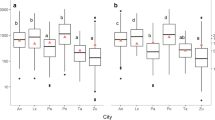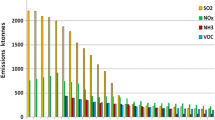Abstract
The olive tree (Olea europaea) is an icon of southern Europe and awidespread evergreen in mainland Portugal. First results of a continuing studyon the ability of olive-tree bark to act as an air-pollution biomonitor arepresented and discussed here. Other than lower signals and an anticipatedsystemic control over some elements, there seems to be no a priori reasonfor ruling out the possibility of using bark in atmospheric trace-elementsurveys. In fact, nonparametric statistics show that, despite their relativemagnitude, the variation patterns of bark and lichen concentrations significantlyfollow one another all across the study area.
Similar content being viewed by others
References
P. L. Nimis, in EUR 13060 EN Report, A. G. Colombo andG. Premazzi (Eds), Commission of the European Communities, Luxembourg, 1990, p. 93.
W. Nylander, Bull. Soc. Bot. Fr., 13 (1866) 364.
D. H. S. Richardson, Pollution Monitoring with Lichens, Richmond Publishing, Slough, 1992.
F. Arnold, Ber. Bayer. bot. Ges., 1–2, 5–8 (1901) suppl.
M. A. S. Burton, Biological Monitoring of Environmental Contaminants (Plants)-A Technical Report, MARC, London, 1986.
W. E. Winner, in: Lichens, Bryophytes and Air Quality, T. H. Nash III andV. Wirth (Eds), Cramer, Berlin-Stuttgart, 1988, p. 141.
K. J. Puckett, Bibl. Lichenol., 30 (1988) 231.
B. Staxang, Oikos, 20 (1969) 224.
G. P. O'Hare, J. Biogeogr., 1 (1974) 135.
K. Grodzinska, Water, Air, and Soil Pollut., 7 (1978) 3.
K. Grodzinska, in: Monitoring of Air Pollutants by Plants-Methods and Problems, L. Steubing andH.-J. JÄger (Eds), Dr. W. Junk Publishers, The Hague, 1982, p. 33.
O. Haertel, in: Monitoring of Air Pollutants by Plants-Methods and Problems, L. Steubing andH.-J. JÄger (Eds), Dr. W. Junk Publishers, The Hague, 1982, p. 137.
P. Kuik,H. Th. Wolterbeek, Envir. Monitor. Assess., 32 (1994) 207.
L. Steubing, in: Monitoring of Air Pollutants by Plants-Methods and Problems, L. Steubing andH.-J. JÄger (Eds), Dr. W. Junk Publishers, The Hague, 1982, p. 19.
M. C. Freitas,M. A. Reis,L. C. Alves,H. Th. Wolterbeek, Environ. Pollut., 106 (1999) 229.
M. C. Freitas,E. Martinho, Anal. Chim. Acta, 219 (1989) 317.
M. C. Freitas,M. A. Reis,L. C. Alves,H. Th. Wolterbeek, in: Trace Elements-Their Distribution and Effects in the Environment, B. Markert andK. Friese (Eds), Elsevier Science, Amsterdam, 2000, p. 187.
J. O. Nriagu, Nature, 338 (1989) 47.
Author information
Authors and Affiliations
Rights and permissions
About this article
Cite this article
Pacheco, A.M.G., Freitas, M.C., Barros, L.I.C. et al. Investigating tree bark as an air-pollution biomonitor by means of neutron activation analysis. Journal of Radioanalytical and Nuclear Chemistry 249, 327–331 (2001). https://doi.org/10.1023/A:1013293814789
Published:
Issue Date:
DOI: https://doi.org/10.1023/A:1013293814789




